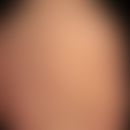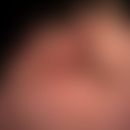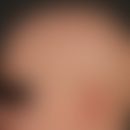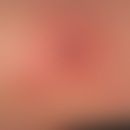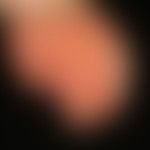Synonym(s)
DefinitionThis section has been translated automatically.
Chronic form of eczema in infants which, in contrast to seborrheic eczema in children, does not manifest itself before the age of 3 months.
EtiopathogenesisThis section has been translated automatically.
Various factors are discussed, including nutritional disturbances/allergies (cow's milk, egg, acidic foods, tomatoes), dysfunction of the sebaceous glands, infections caused by Malassezia species. Real food allergies, however, are only found in about 1/3 of infants.
You might also be interested in
ManifestationThis section has been translated automatically.
In the 1st year of life, not before the 3rd month of life.
LocalizationThis section has been translated automatically.
Onset on cheeks, then capillitium, neck, extremities (extensor rather than flexor), possibly entire body surface.
ClinicThis section has been translated automatically.
Differently pronounced, chronically persistent or recurrent dermatitis, which can range from mild sebostasis to diffuse erythema to extensive foci of inflammation of the skin.
In addition to diffuse scaly erythema, small papules, papulovesicles or scaly plaques may form. This is always accompanied by varying degrees of often agonizing itching, which does not allow the infants (and their parents) to rest. A transition to weeping, later encrusted eczema plaques is possible (atopic dermatitis of the nummular type).
Often secondary bacterial infections, especially in weeping areas.
Extensive adherent scaly deposits on the capillitium are possible which may evenly cover the entire area of the hairy head. The comparison to burnt milk led to the term crusta lactea or milk crust.
The maximum variant is erythrodermic atopic dermatitis of the infant (see also atopic erythrodermic eczema).
The diaper area typically remains free, even with a pronounced and extensive eczema reaction (important diagnostic sign).
Differential diagnosisThis section has been translated automatically.
Severe atopic dermatitis must be distinguished from clinical pictures in which severe immune deficiencies occur in combination with eczematous changes. These include:
Hyper-IgE syndrome (recurrent pneumonia, skin infections "cold abscesses")
Omenn syndrome (neonatal ichthyosiform erythroderma, alopecia, hepatomegaly, lymphadenopathy, failure to thrive)
Wiskott-Aldrich syndrome (male infants/toddlers, generalized eczema with a petechial note, recurrent infections)
Netherton syndrome (neonatal ichthysiform erythroderma, serpiginous erythema with marginal scaling/ichthyosis linearis circumflexa, rarified scalp hair density, trichorrhexis invaginata)
IPEX (male infants/toddlers, immune dysregulation, polyendocricnopathy, enteropathy, X-linked inheritance. On the skin there is a generalized pruriginous dermatitis, which is partly lichenoid, partly psoriasiform or resembling atopic dermatitis).
CBM-opathies: Immunodeficiencies due to mutations in the CADD11-BCL10-MALT1 complex.
Complication(s)(associated diseasesThis section has been translated automatically.
Associated food allergies: About one in three severely affected infants also has a food allergy. The most common allergies are to white chicken, cow's milk, peanuts, soy or tree nuts.
Children with severe atopic dermatitis show an increased association with attention deficit hyperactivity disorder (ADHD), with the odds ratio increasing with the degree of sleep disturbance. Severely affected children also have more frequent absences from daycare due to illness.
To differentiate severe atopic dermatitis from dermatitic changes in immunodeficiencies, anamnestic evidence, special features of the clinical picture and an orienting laboratory diagnosis are crucial:
- Unusually early manifestation (postpartum or in the first weeks of life)
- Severe, extensive, disseminated infestation (maximum variant: neonatal erythroderma, congenital ichthyosis) with recurrent skin abscesses, chronic candida infections of the skin, mucous membranes and/or nails.
- Therapy-refractory course
- In addition, there are signs of immune dysregulation that are summarized under the acronym GARFIELD and laboratory changes (serum IgE>100jU/l, severe eosinophilia (>1,500/ul), lymphopenia, neutropenia, thrombocytopenia, anemia; hypogammaglobulinemia can be a warning sign of a B-cell defect) (Weins Ab et al. 2024).
TherapyThis section has been translated automatically.
Avoid possible triggering allergens, e.g. milk protein, contact with animal epithelia. Wear air-permeable clothing (preferably cotton). Symptomatic external therapy with caring external agents such as Ungt. emulsif. aq., 2-5% urea cream/lotio (Eucerin 3% urea lotion, R102 ), Penaten oil, 5% dexpanthenol cream (e.g. Bepanthen cream, R064 ), bathing in oil baths (e.g. Balneum Hermal), avoiding irritation and occlusion.
Progression/forecastThis section has been translated automatically.
In the classic type of early childhood atopic dermatitis, after an initial emphasis on the head and neck region and the extensor sides of the extremities, an increasing emphasis on flexion develops in infancy. The nummular type is characterized by a significantly stronger infiltration of the eczematous plaques with only slightly pronounced sebostasis. With more pronounced exudation, colonization with Staphylococcus aureus can usually be detected.
Typical irritative provocation factors in infants are unfavorable clothing (wool-silk-synthetic tights) or baby swimming in highly chlorinated water.
Healing, but transition to adult atopic eczema is also possible.
LiteratureThis section has been translated automatically.
- Baumann U et al. (2010) Primary immunodeficiencies - warning signs and algorithms for diagnosis. In: Vol. 1. edition. D-28323 Bremen: UNI-MED Verlag AG 2010.
- Cunningham-Rundles C et al. (1999) Common variable immunodeficiency: clinical and immunological features of 248 patients. Clin Immunol 92:34-48.
- Monto AS et al. (1993) Acute Respiratory Illness in the Community - Frequency of Illness and the Agents Involved. Epidemiol Infect 110:145-160.
- Weins AB et al. (2024) Severe atopic dermatitis in early infancy: characteristics, challenges and new perspectives in clinical practice. J Dtsch Dermatol Ges 22:350-355.
Incoming links (7)
Crusta lactea; Dexpanthenol cream hydrophilic 5% (nrf 11.28.); Eczema infant eczema constitutional; Leiner's disease; Milk crust; Napkin dermatitis; Urea cream hydrophilic 5 or 10% (nrf 11.71.);Outgoing links (14)
Atopic dermatitis (overview); Atopic erythrodermal dermatitis; CBM opathies; Crusta lactea; Dexpanthenol cream hydrophilic 5% (nrf 11.28.); GARFIELD; Hyper-ige syndrome; IPEX; Netherton syndrome; Omenn syndrome; ... Show allDisclaimer
Please ask your physician for a reliable diagnosis. This website is only meant as a reference.
